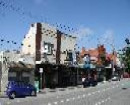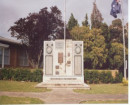Kinnear's Rope Works
124-188 Ballarat Road FOOTSCRAY, MARIBYRNONG CITY
-
Add to tour
You must log in to do that.
-
Share
-
Shortlist place
You must log in to do that.
- Download report
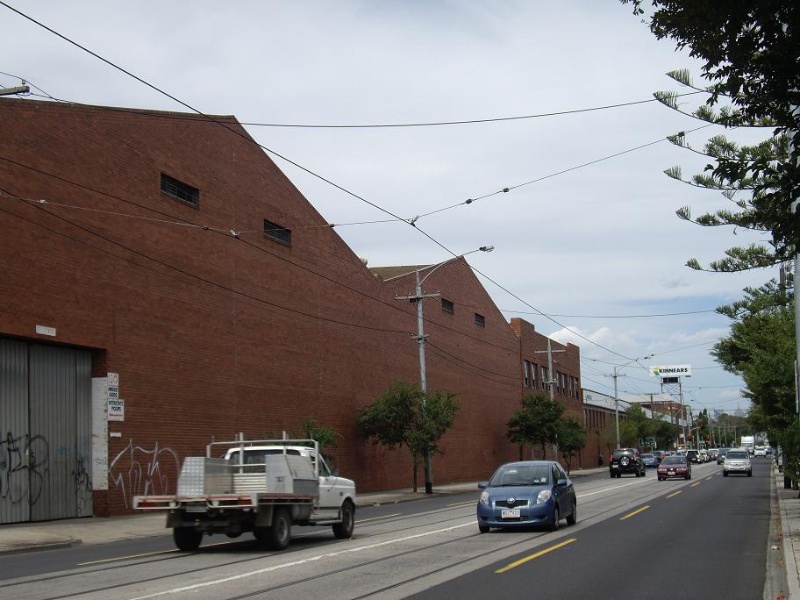

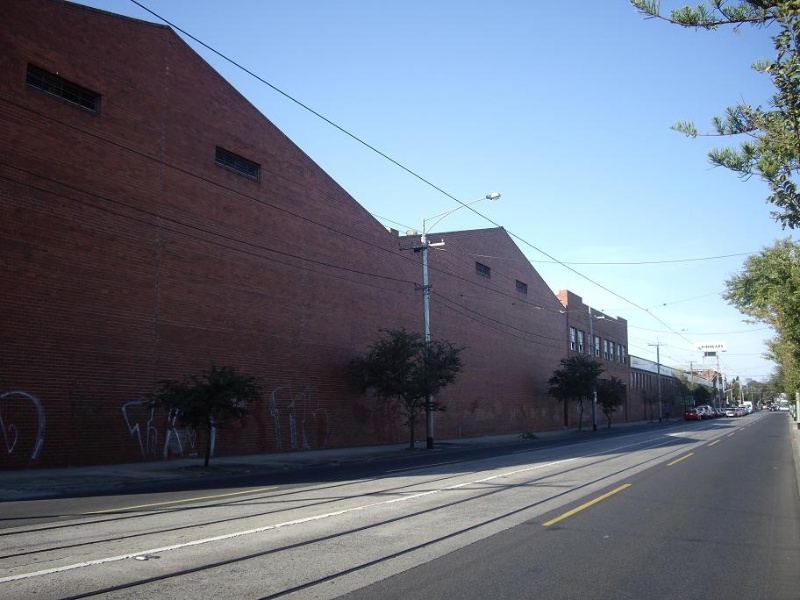
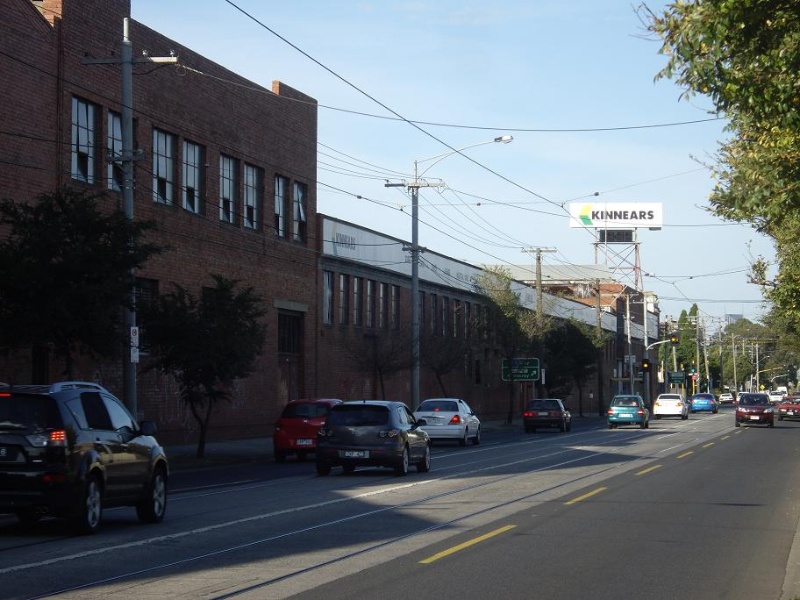
Statement of Significance
Kinnear's rope works is of State historical and architectural significance as one of only a handful of traditional rope making factories to survive in Victoria and one of only two factories which retain a rope walk. The place is of technical significance for the unique rope walk and rope laying machinery. It is of architectural significance as a unique purpose-built industrial building which demonstrates a range of factory building types including the exceptionally long rope walk building, the distinctive saw-tooth roofed twine-spinning buildings, the lantern-roofed boiler and engine houses, and the clerestory-lit and board-lined drafting office.
Along with Miller's Yarraville rope works this is the largest and oldest surviving in Melbourne and the only works retaining evidence of the rope walk. (Criterion A4) The rope walk along Kinnear Street. may be the last surviving example of this form of building in Melbourne, with one other known in Victoria (Dohaghy's in Geelong). (Criterion B2) The rope walk began as an uncovered path or a long alley where strands of fibre were run out to a winding machine which twisted them together. More elaborate systems involved steam power and a building over the walk. (Criterion D2) Kinnears is, however, the only early ropeworks still operating in its original premises in Victoria, Millers Brunswick and Yarraville works being long closed and Donaghy's having closed more recently.
The works is also of historical significance for its association with George Kinnear, who was the pioneer of rope making in Victoria, and his descendants in the firm who were important local identities who had influence in Civic matters and at the industrial level Statewide. (Criterion H1)
Australian Heritage Commission (AHC) criteria
The Australian Heritage Commission criteria consist of a set of eight criteria which cover social, aesthetic, scientific, and historic values. Each criterion has sub-criteria written specifically for cultural or natural values. The relevant criteria are:
A.4 demonstrates well the course and pattern of history, important historic events
B.2 rarity
D.2 good example of type
H.1 association with important person or group
-
-
Kinnear's Rope Works - Physical Description 1
Complex of factory buildings, predominantly saw-tooth roof form with brick walls. The external facade presents a unified tall parapeted red-brick wall with generally steel hopper sash windows and steel lintels (segmental arches to earliest parts). Internal structure is timber king-post truss and sawtooth truss, with some later sections in welded steel. Modern clear span stores have been added to the western end of the site. The rope walk which was originally 1500 foot in length was contained within the long, low, gable roofed building along the northern boundary on the south side of Kinnear Street, which originally extended through to Gordon Street. This is a king-post truss, gable roof form structure of timber framing and corrugated iron cladding. The roof was reclad in new zincalum about 4 years ago, at which time the small towered structure that contained the rope tensioning equipment was removed. At last internal inspection in 1997, the rope walk retained original equipment including the belt driven rope twisting machinery and the traveller which ran on a c30cm diameter steel flanged wheels on light gauge rails. It is believed that at least some of this has been removed. The original western extent of the rope walk is still identifiable by an undeveloped area at the corner of Kinnear and Gordon Streets which has a concrete slab, although the building structure stops well short of this point. Further inspection is required to determine the extent of survival of this machinery.
Distinctive early buildings are evident in the north east corner of the site. The sections with a double hipped roof containing clerestory lights and a roof lantern and the long gabled rope walk parallel to Kinnear Street are probably the earliest parts. Also in the north-west corner of the site, the double timber doors in a segmentally-arched carriage entrance may indicate the original loading out and stables.
One of the lantern roofed sections includes a timber panelled mezzanine/second storey which indicates the former drafting office. The original boiler chimney survives although reduced in height, while the former coal fired boilers are partly intact.Kinnear's Rope Works - Physical Conditions
In good condition and externally intact. Internally the structure is original although equipment has been replaced. The rope walk has recently been reclad, and shortened, and original rope making machinery was in place at last inspection (1997)
Kinnear's Rope Works - Integrity
Externally the works is intact to its Post War state with accretions rather than reconstruction being the pattern of redevelopment. The progressive development of the site is shown in the cohesive red brick elevations to Ballarat Road which represent various periods of construction from the 1900s to 1960s. The Rope walk has been truncated although the footings and tracks can be seen within later buildings and under grass on vacant land at the corner of Gordon and Kinnear Street.
Kinnear's Rope Works - Historical Australian Themes
With rezoning of other industrial land in the area, there may be pressure for closure and redevelopment of the site in the future.
Thematic context
Australian Principal Theme Manufacturing and Processing
PAHT Subtheme: Manufacturing and Processing
Local Theme Industry Consolidation andKinnear's Rope Works - Physical Description 4
Additional Report from: Maribyrnong Industrial Heritage Places, Panel Report, Amendment C31, May 2004, Gary Vines
1.1 Kinnear's Ropeworks
HO90 Submission 2
Following the closure of Kinnear's Ropes, and the sale at auction of most of the machinery and plant, a conservation management plan was commissioned by the owners and undertaken by Robyn Riddett of Allom Lovell & Associates.
This report comes to different conclusions regarding areas which should be included in a heritage overlay, but generally confirms the heritage significance of Kinnear's Ropeworks.
The Allom Lovell conservation management plan proposes varying levels of significance of the various elements listed. It recommends a decreased extent of Heritage Overlay proposed. It also proposes that demolition of contributory elements is acceptable.
The analysis and assessment of significance which forms part of Conservation Management Plan reaches the same conclusion as the Maribyrnong Heritage Review. However, the CMP implementation plan does not align with Council's policy which promotes the retention of significant and contributory elements.
It is the view of the consultant that the contributory elements do meet the minimum threshold for inclusion in the overlay. Also there are not discreet boundaries between the primary significance or core elements and the other elements of the complex. In the case of the laneways, the Allom Lovell report proposes the alignment of the laneways be included in the overlay, but not the fabric. It is the red brick walls which form the significant elements of this aspect, and without the retention of this fabric, the overlay would be meaningless.
The heritage overlay was not prepared in haste as a reaction to the closure of manufacturing on the site, but based on the stated significance of the site which has been published in various documents since the late 1980's.
Some parts of the site clearly do not have contributory significance, namely the 1960s-70s additions on the eastern and western extremes of the site (Buildings 7, 15 and 16)
The overlay as proposed is still appropriate, although it would be feasible to exclude the modern clear-span buildings in the south east corner (Allom Lovell Report Building 7) and at the west of the site (Allom Lovell Buildings 15 and 16). However, the line of the ropewalk along Kinnear Street should still be retained through the site as the rail tracks and some other features can still be discerned.
I think the area for proposed retention shown in the Allom Lovell Report is insufficient to express the significance of the site, which is based on its scale, the variety of its products, distinctive building forms and the length of the ropewalk.
The Larmith and Bulmer Rope Laying machines in Building 7 are impressive and interesting industrial artefacts and among the few surviving large machines on the site which might demonstrate the rope making technology, but these do not appear to be particularly old, or of special importance in the history of the site. There was some machinery of note which survived at least to our site inspection. The most important is the rope winding machinery and remains of control wires, rope laying boxes, tracks and tensioning equipment on the ropewalk. These should be seen as integral to the building fabric and specifically protected in future development.
A detailed response was made for the City of Maribyrnong by the present consultant to the Allom Lovell conservation management plan, as there was an evident need for further appraisal of the site in the light of the detailed information which was produced by the owners. This is reproduced below
Significance
The Conservation Management Plan successfully identifies the significance of the site, but in my opinion it proposes insufficient fabric for retention to adequately conserve the cultural significance. This is because the assessment of most of the buildings (with the exception of the ropewalk) concludes that they are only generic, utilitarian factory buildings. This assessment fails to recognise the intrinsic characteristics of industrial buildings of this type. It also fails to identify the essential attributes which define factory buildings that have been designed for specific purposes. What is needed is a better understanding of the typology of industrial buildings and the unique characteristics which contribute to the significance of an industrial site such as Kinnear's.
Also missing from the Conservation Plan, is the recognition that the site as a whole is significant beyond its component parts. That is, some aspects of its significance, such as the size and scale of the works and the position of Kinnear's as the largest Melbourne ropeworks, can only be appreciated by viewing the total extent of the works. This part of the site's significance is not demonstrated by any individual buildings and could not be maintained by conserving only a token group of structures.
Significance criteria
The critical elements of the significance of the site as recognised in existing studies including the Allom Lovell report can be summarised as follows:
Historical significance
. As one of Victoria's three major ropeworks (c/f. Miller's & Donaghy's) and the largest and longest continually operating in Melbourne (1902-2002)
. For its association with George Kinnear - a dominant industry figure and technological pioneer in rope and fibre
Social Significance
. For the association with the close-knit community of ropemakers and Footscray as the industrial hub of Victoria
. For its role in the war effort
. For its existing and continuing place in local community as a major employer
. As part of a community focus and a workplace of several generations of some families, a key workplace for women, and for post-war migrants
. Local landmark
Technical Significance
. For the rare partially intact ropewalk with early 20th century machinery including winding gear, top cart and galantine
. For the range of building forms which reflect manufacturing processes.
Aesthetic Significance
. The visual and landmark qualities, principally of the expanses of red brick double-height perimeter walls, the dominant chimney, and the extensive signage along the parapet frieze (designed for this purpose).
Factory typology and ability to demonstrate significance
The significance of Kinnear's Ropeworks is expressed in the physical fabric of the factory in several ways:
. its size and scale reflect the importance of the company
. landmark qualities reflect the social and cultural associations
. individual building forms reflect manufacturing processes or building function
Ropeworks/fibre mill typology
A building typology can be recognised in almost all industrial sites. Far from factory buildings being generic, they are almost always designed to a specific purpose and function (perhaps with the exception of modern tilt-slab units).
Buildings within a ropeworks fall into the following categories:
. manufacture
. storage/dispatch
. services - boiler house, engine room
. administration/amenities
Manufacture
The ropewalk requires a long open space or more commonly a basic timber framed, corrugated iron clad shed, 5-10m wide and 400-1000m long. Winding machinery is sometimes housed in a larger section of building at one end, or in adjacent factory space.
Fibre mills for carding, spinning, polishing etc. require functional spaces related to the machinery they contain. The scale of manufacture (in yards produced of a particular type textile) determines the size and shape of the building. The typical mill size at Kinnear's is about 5000 square metres (eg. the jute or hemp mills). This is small compared to clothing textile mills of the period, or modern textile plant. The size reflects the generally specialised nature of the manufacturing carried out by Kinnear's. The number of such separate mills also reflects the range of products - eg sewing thread, string, binder twine, carpet thread, hay band, sash cord, ropes of all sizes and strength, sacking, mesh and the materials used - hemp, jute, sisal, coir, Manila, flax, linen, and, from the 1930s, a vast range of synthetic fibres. Different equipment and production methods were required for each although a major division was generally made between the hard and soft fibre mills.
The building form for the carding, spinning and laying processes was a south-facing sawtooth roof (for good natural light), segmented into smaller production units with partitioning walls to prevent contamination of fibres between products.
Warehouses
The current warehouse areas are concentrated in the most modern buildings (with purpose-built racking) and oldest (redundant) buildings. Storage has generally been secondary to manufacture, and as the spaces needed are more flexible, spaces can be used on an as-needs basis. Loading however, is constrained by vehicle access, which is why the internal roadway system and multiple access points were critical to the design. This allowed access to dispersed storage areas connected to each of the separate manufacturing units.
Ancillary buildings
Before 1920 coal fired boilers and gas suction and/or steam engines were used for motive power. Steam was also used for heat shrinking and treating fibres and rope. Allied to the boiler and engine houses were the engineers' workshops and stores where machines were maintained and repaired. This formed the functional core of the works, its placement chosen for economic design of steam pipes and line shafting.
The administration and staff amenities are also concentrated in the core area, and at the major access to the site, giving the impression of management overseeing the works and the workers. The staff amenities are noteworthy for the dual purpose cafeteria/hall, with its Moderne stage setting. This reflects the strong social and community role of the works.
Recommendations
As Kinnear's Ropeworks is recognised as the largest and most intact of a very small group of specialist industrial sites, and is of historical, technical, social and aesthetic significance, an appropriate extent of retention of fabric should be as follows:
Areas of primary significance should be defined as all parts of the factory with the exception of Buildings 7, 15 and 16, the internal office divisions and other partitions identified in the Allom Lovell Report.
Therefore I would argue that all of the site should be maintained on the Heritage Overlay. All of the buildings apart from 7, 15 and 16, should be included on the Victorian Heritage Register. Future redevelopment should respect the significant fabric thus defined, rather than the token fragments proposed for retention in the Allom Lovell Conservation Management Plan.
Having said this, some of the areas identified as of contributory significance in the Allom Lovell Conservation Plan, may be appropriate for a greater level of intervention and alteration. These include Buildings 6, 12, 13 and 14. Such alteration may include partial removal of internal fabric, including roofs, but not fabric, within two bays of the perimeter of each building.
The Conservation Plan identifies the internal roadways as being of primary significance and to be retained. However, if the adjoining buildings are not similarly protected the laneways would be at risk of loosing integrity. Demolition of the building walls which define the lanes, widening of the lanes, or erection of new structures along the lanes of different form, scale, design or materials, would loose cause the loss of the cultural significance of these areas.
The Conservation Plan also omits any of the major manufacturing sections (with the exception of the rope walk) in its designation of primary significance or areas to be retained. The consequence is that none of the most characteristic building forms - the timber and steel framed sawtooth roof section- would be retained in the Allom Lovell proposal.
Some control over any new structures and infill in the adjacent areas (which do not contain significant elements) would be desirable such as the southeast corner, and the western end.
The ropewalk once extended all the way to Gordon Street to the west, and some archaeological evidence of this survives. Elsewhere on the site there is potential for archaeological evidence of earlier structures and configurations of the site. This should be recognised by the Conservation Management Plan (but is not) and should also be documented by recording those parts of the site with archaeological potential, on the Victorian Heritage Inventory.
It is therefore recommended that the proposed overlay should be re-drawn to apply to only the contributory components of the site.
Kinnear's Rope Works - Physical Description 3
Level of Significance state
Creation date (s): 1902 Map (Melway) 42 B2
Boundary description The extent of the current allotment, excluding the modern clear-span building number 7 in the south east corners and 15 and 16, at the western end of the site.
Local Government Area: City of Maribyrnong
Ownership Type Private
Heritage Study and Grading
Maribyrnong - Maribyrnong Heritage Review
Author: Jill Barnard, Graeme Butler, Francine Gilfedder & Gary Vines
Year: 2000
Grading:
-
-
-
-
-
SOLOMON'S HOUSE
 Victorian Heritage Inventory
Victorian Heritage Inventory -
Footscray North Primary School, SS4160
 Maribyrnong City
Maribyrnong City -
ETA Factory
 Maribyrnong City H1916
Maribyrnong City H1916
-
'Mororo' 13 Oxford Street, Malvern
 Stonnington City
Stonnington City -
1 Arnold Street
 Yarra City
Yarra City -
1 Austin Street
 Yarra City
Yarra City
-
-





